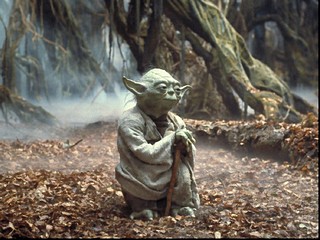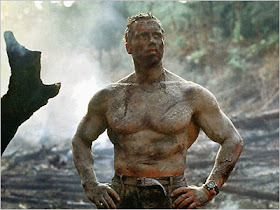Sneaking between genres like a metaphor hunting ninja, I will today look at the perception of the organic and natureness in the world of popular movies.
Star Wars, Shrek, Predator, Apocalypse Now
When nature is presented in films it is in one of three forms, something to appreciate, something to be feared or something that's just disliked/a pain in the arse.
Star Wars
 When Luke Sky-walker crash-lands on Degobah he makes the assumption that he has travelled there in error as there is no sign of civilisation. He takes for granted that he won't find a Jedi Master in 'a place like this'.
When Luke Sky-walker crash-lands on Degobah he makes the assumption that he has travelled there in error as there is no sign of civilisation. He takes for granted that he won't find a Jedi Master in 'a place like this'.When he meets Yoda, the decrepit little alien is a few banthas short of a herd, so to speak, because he hasn't been around people for a couple of decades.
So this typifies what happens when you're away from civilisation completely, you go a bit nuts, but on the other hand, being surround by this abundance of life (in the absence of distraction) allows Yoda to feel the full power of the force.
Shrek
This movie is an example because everyone has seen it. Even the royal family on Omicron Persei 8 watch it every year at Christmas. As an ogre who lives in a swamp, this was a fresh and satirical look at the typical fairytale and it's heroes. The film starts with a chronicle of Shrek's regular day, enjoying nature in all it's sludgy glory, taking a mud bath, brushing his teeth with slug innards...
The film does a good job of promoting the wild, the messy and the unkempt. Shrek's life on the swamp, or eating rotisserie weed rat in a field, seems a lot more appealing than the forced sterility of Dulock where the villain lives.
Overall a better lesson for kids than Snow White. Ahhh the forest is so scary, I better move in with seven little men and do all their washing.
Predator
 In the golden age of Arnie movies this one pits an elite team of soldiers against an invisible alien predator, and it's set in the jungle somewhere (can't remember, doesn't matter). Spoiler alert: Typical format. There's a pretty girl who joins the group and one by one they all die except her and Arnie. The native American guy is the only one to face his death with dignity as he refuses to run and instead lays down a challenge for the ultimate predator.
In the golden age of Arnie movies this one pits an elite team of soldiers against an invisible alien predator, and it's set in the jungle somewhere (can't remember, doesn't matter). Spoiler alert: Typical format. There's a pretty girl who joins the group and one by one they all die except her and Arnie. The native American guy is the only one to face his death with dignity as he refuses to run and instead lays down a challenge for the ultimate predator.Initially the soldiers rely on the prowess of their weaponry but it soon becomes apparent that the only way Arnie's gonna kill this ugly mother is by covering his abs in mud and making traps out of sticks. Nature one, technology zero (sort of). This film presents nature as a dangerous place unless you can learn to work with it.
Apocalypse Now
This movie is kind-of based on the novella Heart of Darkness, but it's set in South East Asia (during the Viet Nam conflict), where as the book is set in Africa (Victorian era). Both follow a disturbing journey into the jungle going upstream on a boat with an untrustworthy crew. I bloody love this movie, it's so messed up.
There is a lot of symbolism here. Civilisation is slowly left behind as darkness descends and they penetrate deeper into the jungle. You get the sense that the boat, the last scrap of civilisation, is the only remotely safe place to be. The unforgiving jungle offers grave threats and the people they encounter here bear less relation to regular society the further in they go.
Finally, at the terminus, things are really bat shit. Captain Willard emerges from the river as though it has transformed him into a primitive hunting creature. By the time Marlon Brando whispers 'The horror, the horror', you just want to stay away from the woods for ever. The lack of credits at the beginning or end make the experience feel like more than a regular movie.
If anyone is interested in more conceptual babble, please read on...
With the help of these Venn diagrams I knocked up in about 20 seconds I will explore the way nature is perceived, nicking bits from an interesting lecture I heard two years ago.The bottom one represents those people who are entirely separated from nature in their day-to-day lives, they are simply disinterested in it. Typically, but by no means in all cases, this type of person lives in the city, for obvious reasons.
They work in the city, it provides for all their needs and urges. At two in the morning you can still go shopping and buy coffee (if you feel the need for it). They are always air conditioned or centrally heated to the perfect temperature Nature involves being eaten by flies and having little or no 3G signal. It's out there and I'm in here and I'm happy with that, because it's got nothing to offer.
A person in the opposite extreme might belong to one of the rare peoples who live more or less like their ancestors have for hundreds/thousands of years. Gathering food from the surrounding habitat and being heavily influenced by their natural environment. Heat wave, flood, storm, drought, pests, predators. They might also belong to a group of 'modern' people who make a living from the natural environment but are not inherently 'poor' e.g. park ranger, Ray Mears.
As more and more people move to the city, there are more people like the bottom diagram than the middle one. However at the moment most western people belong to the top diagram, where nature has some role for 'you'. You might enjoy a walk somewhere rural, you might enjoy gardening, you might enjoy watching swallows in the summertime or find the local park a peaceful place to be (unless you find that peace drinking cider on a bench, that's not being touch with nature).
When the countryside is only populated by a few hermit-like Yoda characters, will the cities, populated by people disinterested in the offerings of nature still place any value on it other than somewhere to grow food and collect water?

Brilliant, made me laugh out loud whilst still being insightful!
ReplyDelete